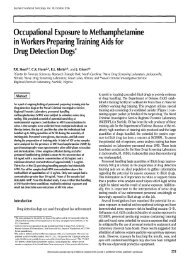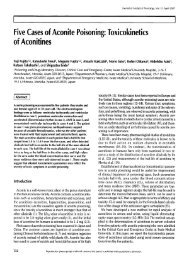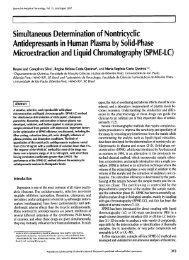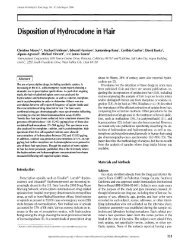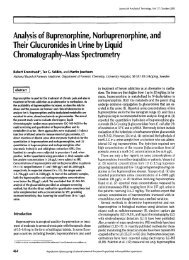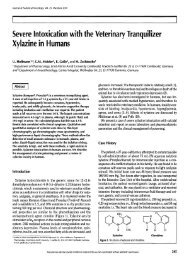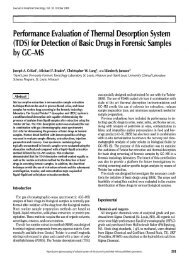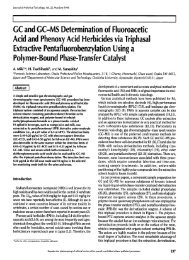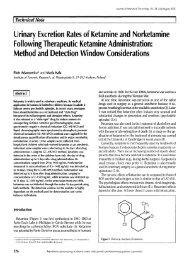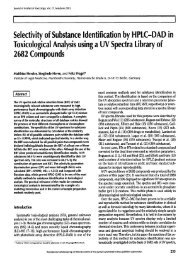Cyanide and Thiocyanate in Human Saliva by Gas - Journal of ...
Cyanide and Thiocyanate in Human Saliva by Gas - Journal of ...
Cyanide and Thiocyanate in Human Saliva by Gas - Journal of ...
You also want an ePaper? Increase the reach of your titles
YUMPU automatically turns print PDFs into web optimized ePapers that Google loves.
CA) was 8-10 psi. The <strong>in</strong>strument was operated <strong>in</strong> splitless <strong>and</strong><br />
temperature program modes. To avoid peak tail<strong>in</strong>g, the purge<br />
valve was turned on at 0.50 ra<strong>in</strong> after sample <strong>in</strong>jection. The<br />
MSD was operated <strong>in</strong> electron impact mode at 70 eV. The de-<br />
tector was <strong>in</strong>itially <strong>of</strong>f <strong>and</strong> was turned on after a strong reagent<br />
peak <strong>of</strong> PFB-Br (approximately 3.0 ra<strong>in</strong>).<br />
Preparation <strong>of</strong> st<strong>and</strong>ards <strong>and</strong> reagents<br />
Stock solutions <strong>of</strong> CN <strong>and</strong> SCN were prepared at a concen-<br />
tration <strong>of</strong> 10 mmol/L <strong>in</strong> water. Work<strong>in</strong>g solutions <strong>of</strong> CN/SCN<br />
at concentrations <strong>of</strong> 0, 25, 50, <strong>and</strong> 100 IJmol/L <strong>in</strong> water were<br />
used for specimen analysis. An SCN control (200 IJmol/L <strong>in</strong><br />
water) was used to monitor artifact formation <strong>of</strong> CN. The<br />
phase-transfer catalyst (TBAS, 10 mmol/L) was prepared <strong>in</strong> a<br />
saturated solution <strong>of</strong> sodium borate (pH 9.2). Derivatiz<strong>in</strong>g<br />
agent (PFB-Br) <strong>and</strong> <strong>in</strong>ternal st<strong>and</strong>ard (2,5-DBT) were prepared<br />
<strong>in</strong> ethyl acetate at concentrations <strong>of</strong> 20 mmol/L <strong>and</strong> 50 ]Jmol/L,<br />
respectively. All solutions were stored at 2-5~ except the<br />
TBAS solution, which was left at room temperature. The<br />
reagents were stable for at least six months. For K6nig color<br />
reaction, 0.6 g <strong>of</strong> barbituric acid was dissolved <strong>in</strong> 10 mL <strong>of</strong> a<br />
mixture <strong>of</strong> pyrid<strong>in</strong>e <strong>and</strong> 1M hydrochloric acid (3:7, v/v). The<br />
solution had a short shelf-life <strong>and</strong> was prepared before the<br />
analysis.<br />
Preparation <strong>of</strong> saliva samples<br />
Ten unstimulated saliva (oral fluid) specimens were col-<br />
lected from three male (M1, M2, M3) <strong>and</strong> two female (F1, F2)<br />
nonsmok<strong>in</strong>g subjects who expectorated directly <strong>in</strong>to<br />
polypropylene collection tubes. The wait<strong>in</strong>g time was at least<br />
a week when collected from the same subject. Approximately<br />
3 mL <strong>of</strong> saliva was centrifuged at RCF 7300 xg for 30 ra<strong>in</strong>. For<br />
analysis, 0.5 mL <strong>of</strong> the clear solution was diluted to 5 mL with<br />
water for a 10-fold dilution.<br />
Extractive alkylation procedure<br />
Solutions <strong>of</strong> 0.3 mL <strong>of</strong> PFB-Br (20 mmol/L), 0.2 mL <strong>of</strong> 2,5-<br />
DBT (50 lJmol/L), <strong>and</strong> 0.8 mL <strong>of</strong> TBAS (10 mmol/L) were<br />
added to 0.2 mL <strong>of</strong> st<strong>and</strong>ards (CN/SCN 0, 25, 50, 100 ]Jmol/L),<br />
control (SCN 200 IJmol/L), <strong>and</strong> saliva specimens <strong>in</strong> 5-mL glass<br />
centrifuge tubes. The tubes were capped, vortex mixed for 1<br />
m<strong>in</strong>, <strong>and</strong> heated at 55~ for 30 ra<strong>in</strong> <strong>in</strong> a water bath. The solu-<br />
tions were centrifuged at RCF 1700 x g for 5 ra<strong>in</strong>, <strong>and</strong> ap-<br />
proximately 100 IJL <strong>of</strong> the clear ethyl acetate solutions was<br />
transferred <strong>in</strong>to screw-capped <strong>in</strong>jection vials.<br />
GC-MS analysis<br />
The oven temperature was <strong>in</strong>creased from 60~ (held for 1.0<br />
ra<strong>in</strong>) to 90~ at 10~ <strong>and</strong> then to 150~ at 30~<br />
Both <strong>in</strong>jector <strong>and</strong> detector were set at 200~ Ions monitored<br />
were as follows: m/z 207, 188, <strong>and</strong> 157 for PFB-CN; m/z 239,<br />
181, <strong>and</strong> 161 for PFB-SCN; m/z 250 <strong>and</strong> 169 for 2,5-DBT (IS).<br />
Electron multiplier was set 200 V above autotune. To enhance<br />
sensitivity, PFB-CN <strong>in</strong> one group <strong>and</strong> PFB-SCN <strong>and</strong> IS <strong>in</strong> an-<br />
other group were monitored. Approximately 1-3 IJL <strong>of</strong> the<br />
ethyl acetate solution was <strong>in</strong>jected onto the <strong>in</strong>strument. The<br />
retention times for PFB-CN, PFB-SCN, <strong>and</strong> 2,5-DBT were 3.37,<br />
5.16, <strong>and</strong> 5.41 ra<strong>in</strong>, respectively.<br />
512<br />
<strong>Journal</strong> <strong>of</strong> Analytical Toxicology, Vol. 30, October 2006<br />
K~nig color test for saliva specimens<br />
The procedure was the same as that used to test CN <strong>and</strong> SCN<br />
<strong>in</strong> blood with m<strong>in</strong>or modifications (18). A solution <strong>of</strong> 0.8 mL<br />
<strong>of</strong> perchloric acid (0.33 tool/L) was added to 0.2 mL <strong>of</strong> stan-<br />
dards (SCN 0, 25, 50, 100, 150 tJmol/L) <strong>and</strong> saliva specimens.<br />
After 2 ra<strong>in</strong> <strong>of</strong> oxidation <strong>of</strong> SCN to CN, 0.2 mL <strong>of</strong> sodium ac-<br />
etate (1M) <strong>and</strong> 60 IJL <strong>of</strong> sodium hypochlorite (50 mmol/L)<br />
were added to the solutions. The so]ution was mixed, <strong>and</strong><br />
with<strong>in</strong> a m<strong>in</strong>ute, 0.2 mL <strong>of</strong> barbituric acid-pyrid<strong>in</strong>e reagent<br />
was added. After 5 ra<strong>in</strong>, the absorbance was recorded at 583<br />
nm. The <strong>in</strong>strument was set to zero us<strong>in</strong>g a water blank prior<br />
to analysis <strong>of</strong> specimens.<br />
Results <strong>and</strong> Discussion<br />
In extractive alkylation, CN <strong>and</strong> SCN <strong>in</strong> an aqueous solution<br />
reacted poorly with PFB-Br <strong>in</strong> ethyl acetate. But with the use<br />
<strong>of</strong> TBAS as a phase-transfer catalyst the reaction began im-<br />
mediately (CN ~ PFB-CN, SCN ~ PFB-SCN). After 30 m<strong>in</strong> <strong>of</strong><br />
reaction, the total ion chromatogram (TIC) areas were greater<br />
than 177,000 <strong>and</strong> 25,000 after an on-column <strong>in</strong>jection <strong>of</strong> 5 pi-<br />
comol (0.29 ng) <strong>of</strong> SCN <strong>and</strong> 12.5 picomol (0.33 ng) <strong>of</strong> CN, re-<br />
spectively. In both cases the background was less than 1%. The<br />
reactions were studied over a period <strong>of</strong> 120 ra<strong>in</strong>. When moni-<br />
tored <strong>by</strong> ion/IS ratios, the reactions were almost complete<br />
after 90 ra<strong>in</strong> for both CN <strong>and</strong> SCN. Because <strong>of</strong> the excellent on-<br />
column sensitivity, we ran the reaction for only 30 ra<strong>in</strong>. At this<br />
reaction time, the yield was 55-65% for both CN <strong>and</strong> SCN. In<br />
GC-MS analysis, three ions from PFB-CN <strong>in</strong> one group <strong>and</strong><br />
Table I. <strong>Cyanide</strong> <strong>and</strong> <strong>Thiocyanate</strong> (pmol/L) <strong>in</strong> Ten <strong>Saliva</strong><br />
Specimens Collected from Three Male (M) <strong>and</strong> Two<br />
Female (F) Nonsmok<strong>in</strong>g Subjects*<br />
Colorimetric<br />
GC-MS Method Method<br />
(CN + SCN) CN/SCN (CN + SCN)<br />
<strong>Saliva</strong> CN SCN pmol/L % pmol/L<br />
M1-1 29 794 823 3.7 929<br />
M1-2 11 442 453 2.5 555<br />
M1-3 12 741 753 1.6 825<br />
M1-4 8.2 1029 1037 0.8 1056<br />
M1-5 5.7 595 601 1.0 634<br />
M2-1 4.8 293 298 i .6 323<br />
M3-1 8.8 463 472 1.9 494<br />
F1-1 6.9 726 733 1.0 797<br />
F1-2 15 771 786 1.9 815<br />
F2-1 17 573 590 3.0 615<br />
M<strong>in</strong> 4.8 293 298 0.8 323<br />
Max 29 1029 1037 3.7 1056<br />
Median 9.9 661 667 1.8 716<br />
Average 11.8 643 655 1.9 704<br />
Std 7.2 213 215 0.9 220<br />
* Method comparison for (CN + SCN), <strong>in</strong>tercept = -26.7, slope = 0.9673,<br />
r = 0.9882.



